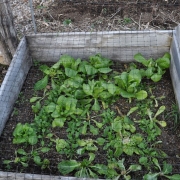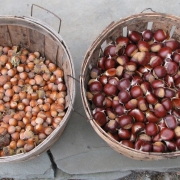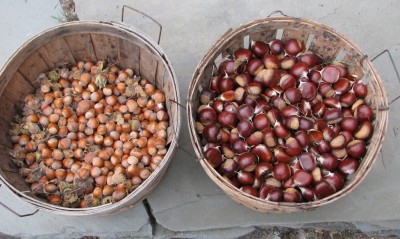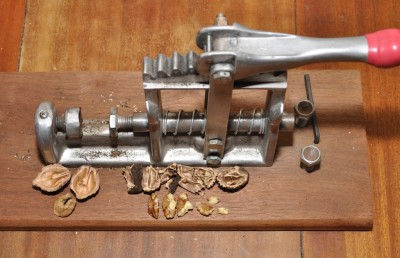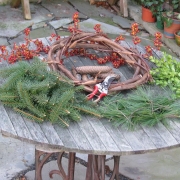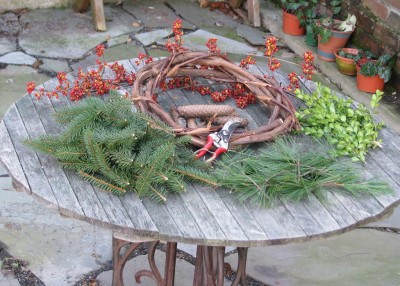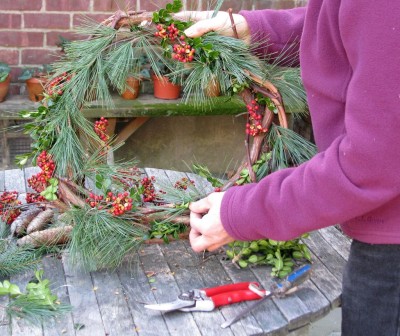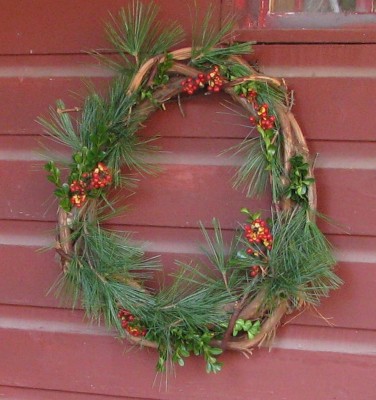SALAD TUNNELS & COLDFRAMES, AND INDOOR “PINE”
/1 Comment/in Design, Gardening, Vegetables/by Lee A. ReichCold has yet to throw a wrench into salads fresh from the garden — even though December 16th saw a night-time low of 12°F. Yes, the lettuce would be mush if unprotected but under the sheltering clear plastic and wooden sides of my 5 foot square cold frame, the plants are barely scathed. Just a few leaves wilted at their edges. Spinach that I sowed between the lettuce plants, for harvest after the lettuce is finished is still looking spry.
Plastic tunnels supported by wire hoops are offering almost as much cold protection over 3 garden beds. Beneath them, mustard greens, endive, and arugula don’t exactly thrive, but do survive.
A few fresh greens are even surviving out in the garden without any sort of protection whatsoever. That would include some arugula that was never covered as well as kale, what’s left of it, and mâche, the most cold-hardy of all salad greens.
Once temperatures plummet or the ground is blanketed with snow, fresh salads will come from the greenhouse, which, with night temperatures never allowed to drop below 37°F., is packed with lush greenery as if it were May.
———————————–
Update: Lettuce in the cold frame is flagging after a night-time low of 8° a few days after that 12° low. Unprotected out in the garden, only mâche and kale survive.
————————————
The holiday tree, only a half a foot tall and ornamented with 3 silver balls, is cute as a button. It’s a Norfolk Island pine (Araucaria heterophylla), a free gift I received a couple of weeks ago from a mail-order nursery. This tree will green up the darkest days of the year for year after year because it’s a tropical species that does well in the eternal warmth and somewhat dry air, in winter at least, of any home.
Over the years, the tree will lose its impishness and develop a straight, upright trunk off of which will grow relatively widely spaced, whorled tiers of horizontal branches, all clothed in green needles. With age, the plant becomes quite majestic. Too majestic, in fact, for any home. I have seen the spreading branches of this tree towering 40 feet or more over the tiled roofs of homes in tropical climates.
So what’s a gardener to do with such a plant, after years of nurturing it and watching it grow? One option, of course, is to bite the bullet and walk it over to the compost pile. Or it could be gifted to a friend with a higher ceiling, but that just shifts responsibility and puts off the inevitable. How about giving it to grandma for her front lawn in Florida?
A natural inclination for any real gardener in this situation would be to try to keep the plant going, not as its original self but in the form of a cutting. The rooted cutting, then, is genetically the same as the original plant, only a smaller version. Norfolk Island pine does root from cuttings especially, as with many conifers, if the cuttings are taken from young growth.
This plan has one problem: fixed plagiotropism. This botanical mouthful signifies the tendency for a horizontal shoot of certain plants to always retain its horizontal growth habit. Put more simply, if a cutting is rooted from one of Norfolk Island pine’s horizontal stems, that stem will always grow sideways to creep along a windowsill or wherever else the plant is growing.
The solution to this problem is to take a cutting from the leading, upright stem. It the mother plant isn’t destined for composting, though, cutting out that leading stem does ruin its form. Also, because young cuttings root best, you might end up with only one cutting, perhaps two, from that short length of young, leading stem. Not much insurance for a plant that doesn’t root all that easily.
The leading, upright stem, of a plant can have the opposite inclination: fixed orthotropism, a permanent, upright growth habit. With other plants, their plagiotropism or orthotropism may be temporary.
Not so for Norfolk Island pine’s plagiotropism. I’ll figure out how to cross that plagiotropic bridge, or not, when I come to it.
(For further discussion of topophysis, which encompasses plagiotropism an orthotropism, and related topics on plant growth, see Plant Form: An Illustrated Guide to Flowering Plant Morphology by Adrian Bell and Alan Bryan.)
WHOSE NUTS?
/4 Comments/in Gardening/by Lee A. ReichNuts are underrated as a food and in the garden. After all, how many gardeners plant nuts? In the landscape, nut plants range from majestic trees to graceful shrubs. As a food, nuts are an excellent source of protein, heart-friendly fats, and all sorts of other nutritional goodies known and unknown. Did you ever see a fat or tired squirrel? (True, we wouldn’t see those couch potato squirrels as they lounged in their den.)
Right now, I am enjoying the fruits of my nutty labors. Some nuts — most nuts that grow around here, in fact — need to be cured before they taste their best. Hazelnuts, ready in September, were good as soon as harvested but even better after resting a couple of weeks. Chestnuts, likewise ready in September, were likewise pretty good immediately, but sweetened after a few weeks in storage. The hazelnuts grow on arching shrubs that could instead be trained to small trees. The chestnuts are picturesque, spreading trees. Both hazelnuts and chestnuts are fast-growing and begin to bear within 5 years or less after planting.
The improvement in flavor from curing is dramatic when it comes to black walnuts and their kin. They were harvested (from the ground) in October, hulled (a messy job), and left outdoors in the sun a few days to dry before being moved to a loft area above the garage. The loft area was cool, airy, and — very important — squirrel-proof. Now they are ready to crack and eat.
—————————————-
Black walnuts are, in my opinion, the best-tasting of the nutty lot. And the trees grow wild throughout much of eastern U.S. This is one nut that I have not planted because I inherited a large tree right on my property. Over the years, new trees have also sprung up to bear nuts. Growth is fast and the trees become quite large. The downside to growing black walnuts for eating is that they are a hard nut to crack. After years of banged thumbs from cracking black walnuts on a concrete floor with a hammer, I purchased the Master Nutcracker, which is elegantly designed, somewhat pricey, but very effective. Separating the nutmeats and picking them out from their cracked shells makes for a convivial accompaniment to after-dinner conversation in winter.
Butternuts, also native to eastern U.S., but not as widespread and currently threatened with a blight, need the same treatment as black walnut and are equally tough nuts to crack. I don’t bother with them because the trees, in contrast to black walnut, are hard to find. Their flavor also has less appeal.
Butternut has naturally and been deliberately hybridized with heartnut, a Japanese-type walnut, to yield what’s known as a buartnut. Many trees thought to be butternuts are actually buartnuts, such as the gigantic, spreading tree I “discovered” in Rosendale a couple of years ago. My young tree, only a few years old, is very fast growing and already shows inklings of future grandeur — and nuts, in the form a few flowers last spring (that, unfortunately, failed to develop into nuts).
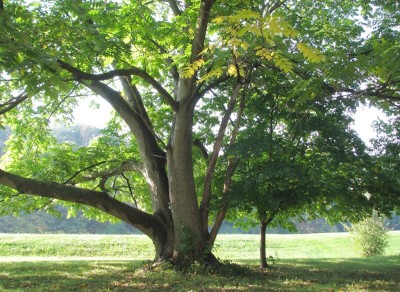 |
| Here’s the Rosendale tree in summer. |
I did revisit the Rosendale buartnut in September and rushed to gather up as many nuts as I could ahead of squirrels, who were also working the tree. Those nuts are now cured. Heartnuts are known for their ease of cracking, a trait also borne out in the buartnut offspring. With the Master Nutcracker, the shells popped open to reveal whole nutmeats. The flavor was mild and a little dry, good for variety and ease of access but not nearly as tasty as black walnuts.
The nut menu needn’t end there. The season here is too short to ripen pecan nuts, although the trees will survive. Enter hicans, hybrids of hickory and pecan with a shorter ripening season. I’ll report back in a few years. Hickories are a native nut that is delicious although small, hard to crack, and yielding little nutmeat. Still, there are some named varieties that improve in all respects. I planted two in the spring of 2011 and hope for some nuts to try within five years. I also have some young Persian walnut trees, the one nut among this bowl of nuts for which I am not hopeful. Persian walnuts blossom early, so the flowers often succumb to subsequent spring frosts, are susceptible to some serious diseases, and — mine, at least — are on a squirrel highway (beneath power lines).
—————————————————-
Have I been mentioning squirrels? Ah, squirrels, once the bane of my nutty endeavors. In years past, these “tree rats,” as they are sometimes nonaffectionately referred to by gardeners, have stripped my hazelnut shrubs bare.
For now, I have the creatures under control. They won’t wander into the high grass that I let rise up through the summer around the hazelnuts. Chestnut burrs are too spiny for them — until the nuts drop out, by which time I’ve gathered them up. My hickories and buartnuts have not yet begun to bear, but the trees are isolated so a temporary squirrel guard of a cylinder of sheet metal should keep the squirrels from climbing. And black walnuts? There are plenty for everyone. The squirrels and I gather them and I still see plenty left on the ground.
HOMEGROWN WREATH
/0 Comments/in Gardening/by Lee A. ReichThe dark green wreath was tied with red ribbons and gliding towards me, in its progress stirring up snowflakes gently floating out of the grey sky. No, the wreath was not hanging from a horse-drawn sled, but was plowing through the frigid air affixed to the chrome grille of a gleaming white Cadillac! Here we are in the twenty-first century, still infusing a breath of life into our winters with cut evergreen boughs, just as did the ancient Egyptians, Persians, Jews, Christians, and Druids.
And it’s true: a few evergreen boughs tied together and accented with a red ribbon do make a doorway more inviting, or a room more cozy in winter. (I’m still undecided about what greenery does for a Cadillac grill.) But going one step further with the greenery, to a bona fide wreath, creates something special. And the actual making of a wreath can be an end in itself this time of year, particularly to the accompaniment of a warm fire and friends and children.
To make a wreath, start with a base. The base might be a sturdy ring of wire (from a coat hanger, for example), or straw that has been bound into a bulky circle with string. Either of these bases can be made from scratch or purchased. For a more natural base, one which might be part of the final design, use a vine such as grape, honeysuckle, wisteria, or bower actinidia. Weave the vine into a circle of triple thickness, tucking in a new piece of vine as an old one ends.
The base might be all, or just about all, that is needed for a simple wreath. I have seen a very attractive wreath that was nothing more than a thick ring of wild rose sprigs showing off a profusion of pastel red fruits. Carefully overlapped sprigs of lavender or rosemary, bound with thin wire to a heavier wire frame, make a dainty, fragrant, blue-green wreath. Thyme is another good plant for this purpose, also fragrant. Keep thyme’s wiry stems somewhat loose, though, because they are as important in adding body to the wreath as are the tiny leaves.
This time of year my penchant is for wreaths that are rich green in color, and almost gaudy with ornamentation. The base for such wreaths is some evergreen plant. Not all evergreens are suitable, because some drop their leaves too readily indoors (and in the brisk wind riding on the front of a car!). Amongst needle-leaf evergreens, juniper, white pine, mugho pine, red pine, and spruce are good choices. Or, for something brighter, needled evergreens with yellow-tipped leaves, such as Gold Star and Kuriwao Sunburst junipers. Mahonia, holly, leucothoe, rhododendron, boxwood, lingonberry, and English ivy are suitable broad-leaf evergreens for a wreath, but none of the broadleaf evergreens will hold their leaves indoors as long as the needle-leaved evergreens.
Wire, glue or tuck small bunches of evergreens onto the base, with all the bunches facing the same direction. Don’t be stingy, because this mass of green color is what is going to calm down and visually hold together the whole wreath.
Next, add accent. Ornaments that are darker shades, and blue or green, make a quieter wreath than ornaments that are lighter shades, and red or yellow. As I said, this time of year I prefer spirited ornamentation, perhaps due to the impending dead of winter. Lively ornaments might include chains of shiny red cranberries or popcorn threaded together, bunches of bright red peppers and garlic clove.
Fruits, like evergreen leaves, flaunt winter’s cold darkness to celebrate the continuity of life from one year to the next. Some brightly colored fruits still clinging to vines and shrubs include mountainash, bittersweet, winterberry, barberry, and, of course, holly. Deck the halls.

